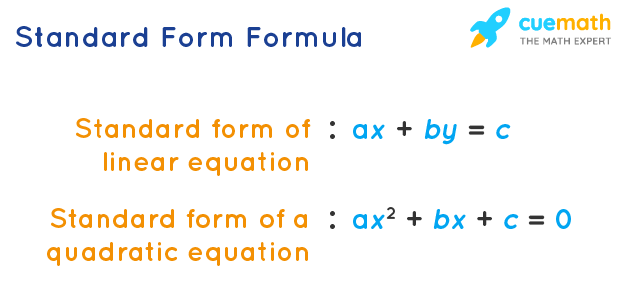Standard Form Formula
The standard form is referred to as the general way of representing any type of notation. The standard form formula represents the standard form of an equation which is the commonly accepted form of an equation. For example - The standard form of a polynomial is to write the terms with a higher degree first (descending order of degree) and its coefficients must be in integral form. Thus, the standard form formula helps in presenting the general representation for different types of notation.
What is the Standard Form Formula?
The formula to represent the standard form formula is based on the degree of the equations. Here we look at the standard forms of simple linear equations and quadratic equations.

Standard Form Formula
-
The standard form of a linear equation is the basic form of an equation. The standard form of a linear equation with two variables and more than two variables is presented below. Here x, y, or (x)1, (x)2, (x)3,.... represent the variables, and a, b, (A)1, (A)2, (A)3, ........ (A)n are referred to as the coefficients. The numerics placed to the right of the equals to sign are called constants.
ax + by = c
(A)1(x)1 +(A)2 (x)2 + (A)3 (x)3 + ........ + (A)n (x)n = D
- The standard form of a quadratic equation is a second-degree equation and has a variable, coefficients, and constant term. Here it is a single variable x of degree 2. The standard form of a quadratic equation is as follows.
ax2 + bx + c = 0
where a ≠ 0
Further, we have standard form formulas for equations of higher degrees. Also in coordinate geometry, we have a standard form for different geometric representations such as a straight line, circle, ellipse, hyperbola, and parabola.
- Straight-line: Ax + By = C, where A is a positive integer, and B, and C are integers.
- Circle: (x - h)2 + (y - k)2 = (r)2, where ( h, k ) is the center and r is the radius.
- Ellipse: \(\frac{x^2}{a^2} + \frac{y^2}{b^2} =1\)
- Hyperbola: \(\dfrac{(x-x_{0})^{2}}{a^{2}}-\dfrac{(y-y_{0})^{2}}{b^{2}}=1\), where (x)0 are the center points, a = semi-major axis and b = semi-minor axis.
- Parabola: (x - h)2 = 4p(y - k)
Let us check a few examples to better understand the Standard Form Formula.

Examples Using Standard Form Formula
Example 1: Convert the following linear equation y = 3x + 4 into standard form.
Solution:
y = 3x + 4
y - 3x = 4
-3x + y = 4
3x - y = -4
Answer: Standard form of the given linear equation is 3x - y = -4
Example 2: Convert the following quadratic equation into standard form: \( \frac{2x^2}{3} = 3x - 7\)
Solution:
\( \dfrac{2x^2}{3} = 3x - 7\)
Multiplying by 3 on both sides,
2x2 = 9x - 21
Shifting R.H.S. terms to L.H.S.,
2x2 - 9x + 21 = 0
Answer: Standard form of the given quadratic equation is 2x2 - 9x + 63 = 0
Example 3: Convert the following quadratic equation into standard form: \( \frac{1}{x} + x = 1\)
Solution:
\( \dfrac{1}{x} + x = 1\)
Multiplying x on both sides,
1 + x2 = x
Shifting R.H.S. terms to L.H.S.,
x2 - x + 1 = 0
Answer: Standard form of the given quadratic equation is x2 - x + 1 = 0
FAQs on Standard Form Formula
What is Standard Form Formula?
The standard form formula refers to the formula presenting the general representation for different types of notation.
What is the Standard Form Formula for Parabola?
The standard form formula of the equation of the parabola is this: (y - k)2 = 4p(x - h), where p≠ 0 only in case a parabola has a horizontal axis.
- The vertex of this parabola is at (h, k).
- The focus is at (h + p, k).
What is the Standard Form for Slope Formula?
The standard form of slope-intercept form of a linear equation is y = mx + b, where m is the slope of the line whereas the standard form of a linear equation is Ax + By = C.
How to Use Standard Form Formula?
We can use the standard form formula depending on the equation, if it's linear, quadratic, etc. Just rewrite the given formulas in the standard form.
- Standard form of linear equation: ax + by = c
- Standard form of a quadratic equation is a second degree equation: ax2 + bx + c = 0
What is the Rule for Standard Form?
Standard form for linear equation in two variables x and y is given as Ax + By = C, where A, B, and C are integers, and A is non-negative, and, A, B, and C have no common factors other than 1.
What is the Standard Form in Math?
Standard form in math is the method of representing a particular element in the most common way. Very large numbers or very small numbers are expressed in the standard form. Mathematical elements such as equations are expressed in a standard form to better solve the problem. In other words, a standard form is a form of writing a given mathematical concept like an equation, number, or expression in a form that follows certain rules.
visual curriculum
